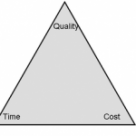Is the iron triangle outdated?
Posted by on Dec 3, 2021 in PMChat Bloggers, Uncategorized | Comments Off

If you are into project management you are probably familiar with the good old iron triangle which is how project management is traditionally measuring the success of a project. It states that projects must be delivered to the triple constraints of time, cost and quality. The iron triangle reflects the view that our role as project managers is to deliver the project to the customer’s specification (quality) within the agreed time and budgetary constraints, which to some extent is true. But it sometimes happens that we deliver a beautifully crafted product, system or device which meets all of the stated requirements, but which somehow ends up not being used the way it was intended, if at all. For the project team (or supplier) this could be seen as a successful delivery as the product met the customer’s stated requirements, but for the customer it is a failure because it didn’t produce any benefits. It did not add any value. The problem may be that the project manager is not taking a broad enough view of what ‘quality’ constitutes, and is not measuring how the project will add value to the client and to society in the short and long term.
Read MoreThe iron triangle and the triple constraints are outdated!
Posted by on Dec 3, 2021 in PMChat Bloggers, Uncategorized | Comments Off

If you are into project management you are probably familiar with the good old iron triangle which is how project management has traditionally measured the success of a project. It states that projects must be delivered to the triple constraints of time, cost and quality The iron triangle reflects the view that our role as project managers is to deliver the project to the customer’s specification (quality) within the agreed time and budgetary constraints, which to some extent is true. But what happens if we deliver a beautifully crafted product, system or device which meets all of the stated requirements , but which somehow ends up not being used the way it was intended, if at all? For the project team (or supplier) this could be seen as a successful delivery as the product met the customer’s stated requirements, but for the customer it is a failure because it didn’t produce any benefits. It did not add any value. In the new world of increased speed, complexity and a more-for-less ethos, we have to take a much boarder view and measure how good we are at adding value and doing the right thing for the client, the project, and for society in the short and long term. Not only is this value-added view the way to successful and sustainable project delivery, it is also the way for project managers to demonstrate their genius and to get to the next level.
Read MoreBring Back Management
Posted by on Nov 26, 2021 in PMChat Bloggers | Comments Off

There’s something about leadership that’s been nagging at me for a while. It’s nothing to do with leadership itself because leadership has a clear and important role to play in business, personal and career development. My nagging niggle is the amount written about leadership; its airtime is huge making it appear like the be-all and end-all of skills for anyone in charge. Yet it seems, to me at least, that other skills and knowledge are suffering. Have the fundamentals of management gone so far out of fashion that they’re being lost completely? I’m all for leadership. Leading a group of people or being part of a group or organisation that is well led is not only good for business but is motivating to such a level that you genuinely believe you can achieve anything
Read MoreTwo Agile Myths- BUSTED!
Posted by on Nov 22, 2021 in PMChat Bloggers | Comments Off

Agile is just a series of waterfalls There’s a lot more to being agile than just shortening the cycle. The waterfall process is defined by stages (or tollgates) that happen in serial – Requirements, Design, Construction, Verification, and then Maintenance. Agile incorporates all of these tasks in parallel, with a focus on collaboration, rapid feedback loops and the embracing of change. Each story (or item of value) moving through an agile queue can be labeled with similar states from waterfall. This does not make the sprint mini-waterfalls. Since the transitions are at the feature/story level (and not at the project level), it just shows the natural progression of an idea.
Read MoreImport TeamPulse Tasks into Google Calendar
Posted by on Nov 18, 2021 in PMChat Bloggers | Comments Off

Google calendar allows importing tasks from a .csv file, so this can be combined with the TeamPulse feature to export work items (including tasks) into the same format. Thanks to this straight-forward export/import process, a portion or all of your project related tasks can be synchronized with any device using Google calendar and you can always keep an eye on your assignments. In order to import your tasks from TeamPulse into Google calendar you need at least: TeamPulse R2 2013 version This TeamPulse version supports both export/import of work items to a .csv file and the creation of custom fields for any work item. Then it is a matter of following 3 easy steps. Pre-conditions: In order to create or import a calendar appointment you’d need as a bare minimum the following tasks properties in TeamPulse. These two are also mandatory for Google calendar to allow import: Subject Start Date The following are not obligatory but nice to have: Description Start Time End Date End Time From the ones above, “Description” already exists, but for the rest you’ll need to create custom fields in TeamPulse as follows: Step1: Create a “Subject” field Start TeamPulse and go to Settings > > Work Items > > Manage Custom Fields > > add “New Field” Then configure the custom field attributes as per the example below: Step2: Create a “Start Date” field Step3: Create a “Start Time” field This is how the modified tasks would look like in TeamPulse.
Read More


